Husqvarna continues its comeback with two all-new dual-sport models for hard-core dirtbike enthusiasts.
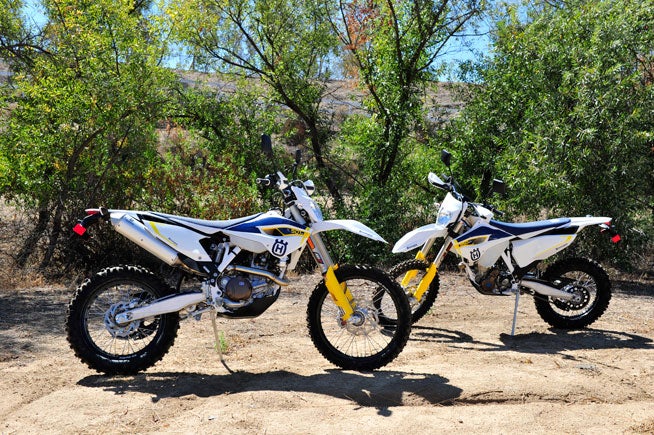
Husqvarna is enjoying a resurgent buzz that rivals Indian, the only difference being that, unlike the American iconic cruiser brand, the Swedish-born Husqvarna has never gone out of business in its 110-year existence as a motorcycle manufacturer. The two brands share similar stories in that both evoke passionate memories of glorious years at the top of their respective genres. And both brands pissed off a lot of their hardcore fans by fumbling the ball.
In the late 1960s and 70s, Husqvarna was the leader in off-road motorcycle sales, earning numerous motocross and off-road championships both in America and around the world. That all changed after a sale to Cagiva led to hard times. The Italians woefully mismanaged the Husqvarna brand in the late 1980s, which led to a wholesale abandonment of the brand by a legion of dyed-in-the-wool Husky fanatics. Husqvarna was tossed from its throne as king of the off-road world, seemingly never to recover.
But Husky never died. Instead, the brand languished for over 20 years, a shadow of its former self. While Husqvarna motorcycle production never ceased, Husky still endured its share of hard knocks, virtually disappearing in a America as constant apathy toward its US dealers by the parent company served as a grim reminder to Husky fans who “remembered when.”
Then, in 2007, Husqvarna got a huge boost when it was purchased by BMW, and Husky’s subsequent purchase by KTM appears to have put it on a healthy single-track to recovery. Husqvarna’s small team of North American executives all share a connection to the brand’s glory years, and they are dedicated to regaining some of the ground lost during the past two decades by pushing forward with an all-new line of KTM/Husaberg-engineered motocross, off-road and dual-sport machines. The 2015 Husqvarna FE 350 S and FE 501 S are the latest to emerge from Husky’s new Austrian digs.
Husky invited us to its North American headquarters, located right next door to KTM in Murrietta, California, to sample the FE 350 S and the FE 501 S, and after putting 100 miles on them, we’re happy to report that both machines more than uphold the honor of the brand’s illustrious Swedish crown logo.
The Gene Pool
The FE 350 S and FE 501 are more than just based on the versatile FE 350 and FE 500 off-road machines that Husqvarna debuted in 2014, they practically are those very models, adorned with the necessary lighting and emissions equipment to certify them for road use. Husqvarna says that the FE 350 S and FE 501 S models are meant to basically be fully capable off-road machines with turn signals, which should satisfy demands by experienced and hard-core off-road riders seeking uncompromised off-road thrills with the convenience of street-going capability.
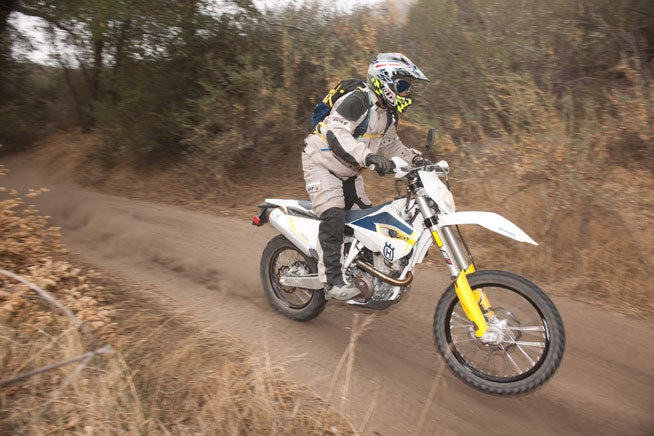
The FE 350 S features the same KTM-designed DOHC, four-valve, four-stroke, single-cylinder engine architecture utilized by factory KTM riders such as Antonio Cairoli and Kailub Russell on their respective World Championship Motocross and AMSOIL GNCC title-winning motorcycles. Premium components abound in the form of its titanium intake and steel exhaust valves, DLC (Diamond-Like Coating) rocker arms, F1-style bridged box piston and Pankl connecting rod and crankshaft, the latter slightly heavier than the unit found in the race machines for improved tractability. The Pankl crankshaft also uses a plain big-end bearing with two force-fitted shells that run directly on the crankpin, which is pressure lubricated. Husqvarna says that this style of bearing allows for increased durability and longer service intervals.
The 350’s 349.7cc engine transmits its power through an innovative DDS (Damped Diaphragm Steel) clutch that uses a single steel diaphragm spring instead of traditional coil springs. There’s also an integrated damping system in the clutch to help ensure smooth control and a light lever pull to help the rider maintain optimal traction when the terrain gets really gnarly. Its wide-ratio six-speed transmission uses ratios designed to make the most of the 350’s high-revving power character, which Husqvarna intended to represent the best of both worlds: the torque feel of a 450cc machine combined with the light weight of a 250 to aid handling.
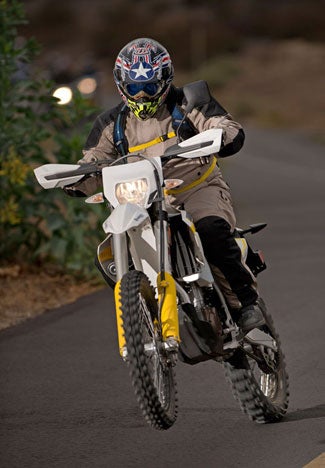
While the engines are derived from KTM, the Husqvarna line differs substantially in the chassis department from its Austrian sisters. Morphed from the now-defunct Husaberg brand, the FE 350 S and FE 501 S main frames are constructed of laser-cut chromoly steel and are fitted with innovative, cross-linked polyamide subframes. Polyamide is a high-tech, carbon fiber-impregnated material that is designed to offer excellent rigidity while offering more flex than aluminum or steel. The unique subframes house the airboxes and electronics while also providing an ideal grab handle. Husqvarna says that while it has only ever seen one subframe component suffer sufficient damage to warrant replacement (one of Husky’s factory riders went down while running wide open in a high-speed desert race), the beauty of the subframe’s multi-piece construction meant that only one piece needed to be replaced in order to make it as good as new. Try doing that with a one-piece aluminum subframe—it ain’t gonna happen.
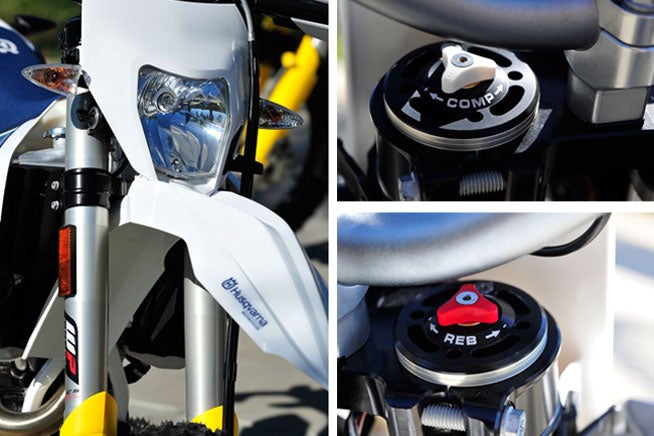
The KTM connection has yielded more than just strong engines and chassis for Husqvarna. It has also facilitated the fitting of the latest and greatest from KTM’s premium in-house suspension firm WP. Accordingly, the FE 350 S and FE 501 S are fitted with CNC-machined triple clamps, 48mm WP 4CS four-chamber forks and DCC (Dual Compression Control) WP monoshocks. The Husqvarna’s differ from the KTMs in that their rear suspension is mounted to Husky’s one-piece cast aluminum swingarms via a progressive linkage rather than being directly mounted to the swingarm sans linkage like the KTMs.
Husqvarna says that the 4CS four-chamber fork represents the pinnacle of WP’s consumer suspension technology by offering the sophisticated capabilities of a closed-cartridge fork with the benefits of an open-cartridge design. Its clicker settings are easily adjustable via dials on top of the fork tubes–rebound (red) is on the right, while compression (white) is on the left. The WP DCC shock is fully adjustable, offering easy compression and rebounding damping tenability as well as preload adjustability. Both the front and rear are set up with spring and valving rates optimized for dual-sport riding.
Husqvarna has also fitted both S models with other swanky parts to maximize their utility on and off the trail. TrailTech’s well-appointed enduro computer comes standard on both, allowing riders to track speed, time and distance. Both machines also sport temperature-controlled cooling fans to keep air flowing through the radiators at slow speeds. The radiator layout is integrated with the chassis, and the radiator hoses route through the frames for better crash protection and a more efficient cooling system. Brembo hydraulic brakes, D.I.D Dirtstar rims and CNC-machined hubs are standard fare, as are heavy-duty skid plates and handguards—two parts that are accessory-only on the KTM EXC dual-sport models.
Let’s Ride
To demonstrate the capabilities of the FE 350 S and FE 501 S, Husqvarna Media Relations Manager Andy Jefferson led us on a 120-mile loop to and from Husky’s Murrietta headquarters through the tall pines of the San Jacinto Mountains to Idyllwild, California. Jefferson brought along a couple of off-road legends to help him, and both are certified Husky royalty—none other than nine-time AMA National Enduro Champion Dick Burleson and four-time AMA National Enduro Champion Terry Cunningham! Husqvarna is justifiably proud of its Swedish history, and recalling Burleson and TC to serve as ambassadors to the brand is only just the beginning of what we expect will be a massive homecoming call to its former racing heroes. Having Burleson and TC with us along made for a very memorable day in the dirt.
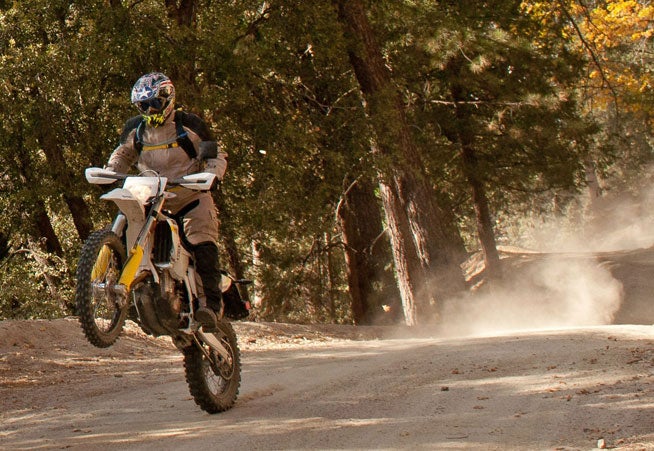
The route consisted of about 4000 feet of elevation change with plenty of fast fire road and rock-strewn two-track sections with silt beds reminiscent of the Baja 1000. Right off the bat, we learned that despite their shared engineering, the FE 350 S and the FE 501 S are two very different animals. Just as the difference in their relative engine displacement would suggest, the 350 is more of a revver, while the 501 capitalizes on its broader and more substantial torque curve. Whiles the 350 does make decent low-end torque, its 88mm bore and short 57.5mm stroke still emphasize 250cc-style thrust, so riding it effectively means keeping its motor spinning in the upper revs, with strict attention paid to fanning its light and linear clutch and rowing its six-speed gearbox. By contrast, the 501’s larger engine, with its squarer 95 x 72mm bore and stroke, offers a lot of grunt, and it is easier to lug along in a taller gear, requiring fewer shifts and only an occasional flick of the clutch lever to keep it churning. Both machines exhibit smooth and precise shifting performance, and both transmissions seem well matched to the respective power curves of the 350 and 501.
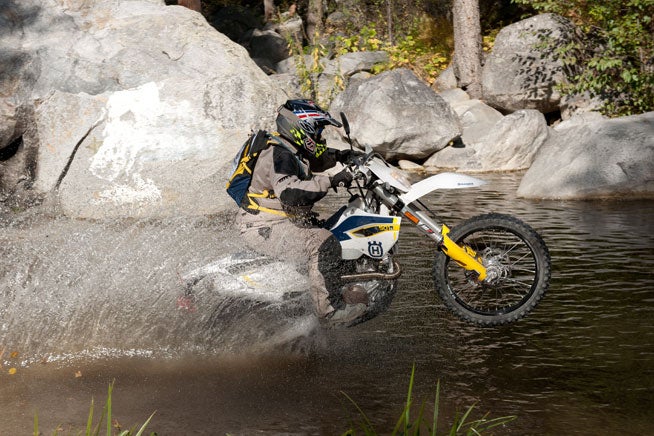
The real difference lies in their handling. What the FE 350 S yields in power to the FE 501 S, is more than made up for in its light and precise steering. While both machines share the same 58.3-inch wheelbase and 26.5-degree rake, the 350’s 242.7-pound claimed weight is just over 8 pounds less than the 501’s, but it feels like 20 when the going gets tight or the terrain gets slippery. Part of this difference is due to the 501’s heavier flywheel, which creates a little extra momentum that has to be compensated for when driving into a loose corner. We found that it was best to chop the throttle a little early to help keep the front end from washing out in flat and slippery corners whereas the 350 could just be stuffed into the same corner and it would stick like glue. The 501 also requires a little more steering with the throttle to exit corners. On the flip side, the heavier 501 is a tad more stable in a straight line over rocky or choppy trails sections.
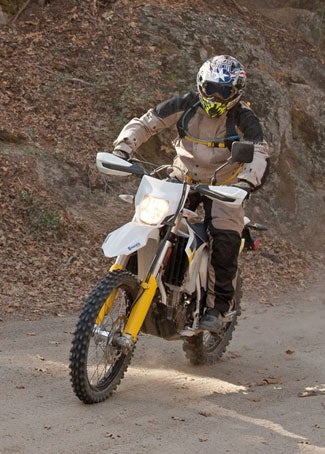
High-quality Brembo brakes are mounted to the CNC-machined hubs of both machines, a 260mm rotor and two-piston caliper up front and a 220mm rotor and single-piston caliper out back. Both offer extremely strong braking, but some off-road riders might find them to be too grabby in off-road conditions. We say that’s simply a Brembo trademark. The brakes are extremely responsive to snatchy fingers and toes at first, but they are easy to get used to, and you’ll only appreciate them more once you do.
We definitely prefer the 501 to the 350 on the street. There, the 501’s broader torque and ample horsepower make rolling along at 70 mph a breeze, and there’s still plenty of reserve power on tap if you need to pass slower traffic. The 350’s motor is a bit of a buzzer at that speed, and that could be a real buzzkill if there are a lot of pavement miles between you and your favorite trails. It’s nothing to worry about on short commutes that don’t require a lot of sustained high-speed motoring, but we really appreciated the smoother feel of the 501 on the 55 mph+ highway sections along our route. The big motor’s user-friendly torque and looser gearing went a long way toward making the FE family’s true dirtbike ergos—and particularly firm seat—bearable when droning.
The bottom line here is that we learned there is no “one size fits all” when it comes to Husqvarna’s FE dual-sport machines. The FE 350 S is a blast to ride when the going gets tight and bumpy or the traction becomes non-existent. It handles like a scalpel, and its suspension is set up amazingly well right out of the crate. The FE 501 S will be a little more of handful in those same conditions, but it is more capable on the street, and its forgiving motor and stable chassis will endear it to less experienced off-road riders despite the weight penalty. Given our choice between the two, we would take a good, hard look at what kind of off-road riding we like to do and how many miles of pavement we had to pound in order to get to it, then we’d decide. If it was over 25 miles, we’d ride the FE 501 S, or we’d tuck the FE 350 S in the bed of our pickup truck. Either way, Husqvarna has introduced two awesome dual sports for 2015, and we’d be supremely stoked to own either one of them.
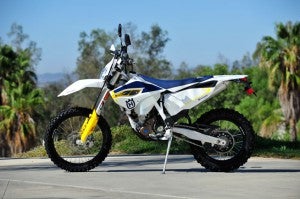 2015 Husqvarna FE 350 S Specifications
2015 Husqvarna FE 350 S Specifications
MSRP: $10,049
Engine Type: 349.7cc liquid-cooled, DOHC, four-stroke Single
Bore and Stroke: 88.0 x 57.5mm
Compression Ratio: 12.3:1
Fuel Delivery: Keihin EFI, 42mm throttle body
Ignition: Keihin EMS
Transmission: Constant mesh, 6-speed DDS (Dampened Diaphragm Steel) wet clutch
Final Drive: Chain
Front Suspension: 48mm WP 4CS inverted fork; compression and rebound adjustable, 11.8-in. travel
Rear Suspension: WP DCC (Dual Compression Control) fully adjustable single shock; 13.0-in. travel
Front Brake: Brembo hydraulic single-disc brake, 260mm
Rear Brake: Brembo hydraulic single-disc brake, 220mm
Front Tire: 80/100-21
Rear Tire: 140/80-18
Wheelbase: 58.3 inches
Seat Height: 38.1 inches
Ground Clearance: 13.6 inches
Fuel Capacity: 2.3 gallons
Color: White/Blue/Yellow
Claimed Wet Weight*: 242.7 pounds
* Weight includes the vehicle with empty fuel tank but with standard equipment and all fluids, including oil and coolant (as applicable).
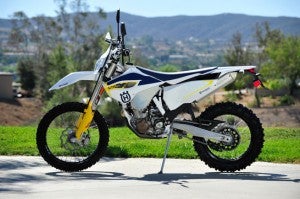 2015 Husqvarna FE 501 S Specifications
2015 Husqvarna FE 501 S Specifications
MSRP: $10,249
Engine Type: 510.4cc liquid-cooled, SOHC, four-stroke Single
Bore and Stroke: 95.0 x 72.0mm
Compression Ratio: 11.8:1
Fuel Delivery: Keihin EFI, 42mm throttle body
Ignition: Keihin EMS
Transmission: Constant mesh, 6-speed DDS (Dampened Diaphragm Steel) wet clutch
Final Drive: Chain
Front Suspension: 48mm WP 4CS inverted fork; compression and rebound adjustable, 11.8-in. travel
Rear Suspension: WP DCC (Dual Compression Control) fully adjustable single shock; 13.0-in. travel
Front Brake: Brembo hydraulic single-disc brake, 260mm
Rear Brake: Brembo hydraulic single-disc brake, 220mm
Front Tire: 80/100-21
Rear Tire: 140/80-18
Wheelbase: 58.3 inches
Seat Height: 38.1 inches
Ground Clearance: 13.6 inches
Fuel Capacity: 2.3 gallons
Color: White/Blue/Yellow
Claimed Wet Weight*: 251.1 pounds
* Weight includes the vehicle with empty fuel tank but with standard equipment and all fluids, including oil and coolant (as applicable).
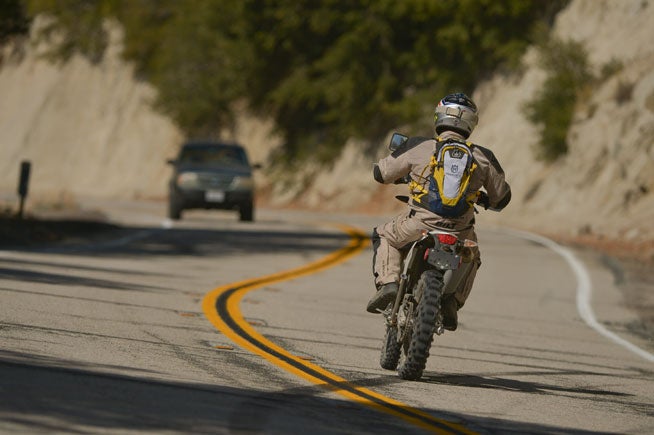
 Your Privacy Choices
Your Privacy Choices